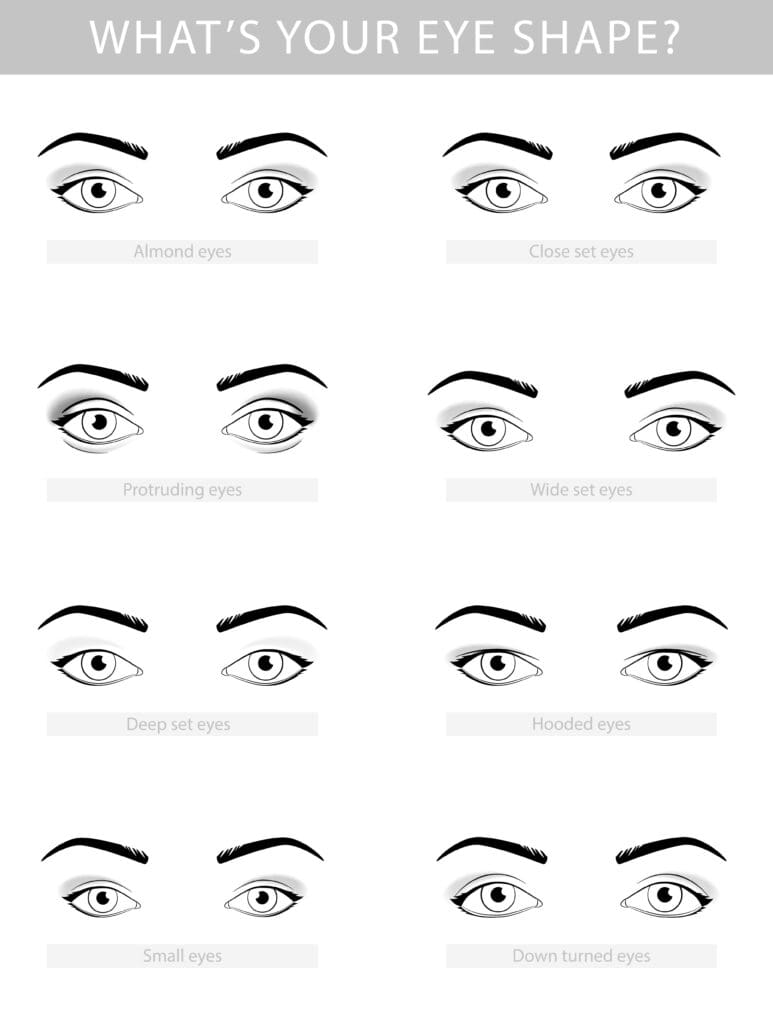How to Tell if You Have Deep-Set Eyes
Last Updated:
Deep-set eyes are one of the common variations we encounter when considering eye shapes. Out of all the varied features of the human face, the eyes are the feature that definitely gets the most attention. We have hundreds of variations on the standard look, such that you could say almost no two sets of eyes are the same. Here, we will explore what deep-set eyes mean, how to tell if you have them, and how that might matter in certain scenarios.
Table of Contents
Most people with deep-set eyes are untroubled by this eye shape variation. However, there are a few medical quirks associated with this eye shape, so read on to find out if you could be affected. Deep-set eyes are one of many conclusions you might come to after determining your eye shape.

What Are Deep-Set Eyes?
Deep-set eyes occur when the eyes are set “further back” in the skull than their normal position. The eyes form a sunken indentation between the brow bone and the cheekbones.
This may give the eyes a shadowed appearance, but it’s otherwise an unremarkable eye shape. The eyes may also appear smaller or the eyelids less pronounced. It can even give you a slight squint or enhance an almond-shaped eye. Deep-set eyes are also typically more prone to have under-eye bags or darkened under-eye circles. Because your brow is more prominent with this eye shape, it can make your eyebrows really “pop,” accentuating your facial character.
Deep-set eyes are different from hooded eyes. Hooded eyes have an extra fold of skin over the upper eyelid. Deep-set eyes can also be found in conjunction with other eye shapes, such as upturned or down-turned eyes (which turn up or down at the far corners).
The opposite of deep-set eyes is protruding eyes, where the eyes are carried a bit forward in the skull and the eyelids and lashes even stick out a bit more.
Deep-set eyes are sometimes referred to as “hunter’s eyes” because they give you the appearance of vigilance, or acute focus. Despite this, deep-set eyes do not have any advantage or disadvantage when it comes to vision.
How to Tell if You Have Deep-Set Eyes
First step: find a mirror to study your eyes in. Natural light is best, but sufficient artificial light works fine. A cosmetic mirror with some magnification built in might help with this exercise.
Try to look at your eyes from a 3/4th side profile, using your peripheral vision. Does your forehead and brow appear to protrude prominently over the eyes? If so, that is a deep-set eye sign.
You deserve clear vision. We can help.
With 135+ locations and over 2.5 million procedures performed, our board-certified eye surgeons deliver results you can trust. Your journey to better vision starts here.
Do you have a very pronounced fold between your brow and upper eyelid? That’s another deep-set eye characteristic.
Finally, find an overhead light source and stand directly under it while holding a mirror at eye level. Does your forehead make a shadow over your eyes, like an awning over a window? That’s also a sign of deep-set eyes.
Deep-set eyes tend to give you a slightly mysterious appearance, and also appear to make your emotions more dramatic since the eyebrows are so prominent.
Deep-set eyes tend to have more bagginess under the eye socket, darker skin tissue around the eye, and sometimes give a squinting appearance. With deep-set eyes, you definitely want to get your full quota of “beauty rest,” because they will show signs of fatigue faster than any other eye shape.
Medical Conditions That Cause Deep-Set Eyes

Deep-set eyes d have a distinguishing characteristic from other eye shapes; there are several medical conditions that can cause this appearance.
Acromegaly – This is a hormonal disorder that leads the pituitary gland to produce too much growth hormone during puberty and into adulthood. This causes the bones to increase in size, including those of the feet, hands, and face. The condition mostly affects middle-aged adults. It can lead to the sudden appearance of having deep-set eyes because the facial bones grow larger. Impaired vision and vision loss are also associated with acromegaly, but these may be caused by pituitary tumors pressing on the eyes.
Sanjad-Sakati syndrome -This is a recessive genetic condition most often found in people of Middle Eastern origin, first described in Saudi Arabia. The condition is associated with slow growth or physical retardation, intellectual disability, hypoparathyroidism leading to nutritional deficiencies, and dysmorphism. Part of the dysmorphism is deep-set, small eyes; however, other aspects of the condition are easily identified and diagnosed during infancy, including smaller facial features and poor immune system. Nutritional deficiency could lead to poor vision. This is not caused by having deep-set eyes.
SHORT syndrome – This condition’s acronym stands for Short stature, Hyperextensibility, Hernia, Ocular depression, Rieger anomaly, and Teething delay. These are the main features of the disorder. Someone with SHORT syndrome has low birth weight and gains weight slowly over childhood, leading to shorter stature. They have a lack of fatty tissue under the skin, which presents mostly in the face, arms, and chest, and this can lead to the appearance of deep-set eyes. Their teeth erupt later so teething begins in later childhood. They have Rieger anomaly, which can lead to glaucoma later in life.
There are no particular vision anomalies associated with deep-set eyes. There are some hormonal or chromosomal conditions that may impact the general facial shape, but it’s not as if deep-set eyes was a measure of diagnosis for specific problems.
One last note: As we age, all of us have a tendency to have our eyes appear to become more deep-set by middle age. This is barely noticeable and has more to do with natural aging, changes in skin texture, muscle wear, wrinkles, and so on. The body tends to lose collagen, a body protein associated with skin texture, as we age. The most prominent spot where collagen loss is noticeable is in the region around the eyes.
Possible Treatment Options For Sunken Eyes
While deep-set eyes are not an issue on their own, they do make you more prone to appear to have sunken eyes later in life. Sunken eyes are their own matter, usually appearing later in life due to aging, lifestyle choices, consistent sleep loss, stress, or other factors.
Sunken eyes appear loose in the eye socket, and give a hollowed-out appearance with dark circles around the eyes, or more pronounced wrinkles. They tend to make you look tired or stressed. One prominent feature of sunken eyes is a pronounced “tear trough,” a diagonal line that starts near the nose and lies across the top of the cheekbone.
Those with deep-set eyes may want to be vigilant for signs of sunken eyes by later in life, and address them with cosmetic surgery if it becomes a concern. There’s a few treatments to help with aesthetic appearance in this case:
- Dermal fillers – This is an injection of filling material under the eyes. It helps replace the lost collagen as we age, helping the eyes appear more robust and less shadowed.
- Anti-wrinkle injections – These help smooth wrinkles around the eyes and also prevent new wrinkles from forming.
- Ultrasound – “Ultherapy” helps stimulate the production of new collagen in the face.
- Laser treatments – This erases the surface appearance of wrinkles and darkened skin.
- Skin creams – Over-the-counter formulas for lightening the skin and maintaining the skin texture.
Deep-Set Eyes? You’re in Good Company!
Deep-set eyes are a common eye shape throughout the world, slightly more common in people with middle Eastern or south European ancestry.
Celebrities who have deep-set eyes include Oprah Winfrey, Leonardo DiCaprio, Jennifer Anniston, Taylor Swift, Kim Kardashian, Cameron Diaz, Demi Moore, Tom Cruise, and Brad Pitt. Given the number of celebrities in the deep-set eyes club who are noted for their good looks, you might just bank on deep-set eyes as an asset.
You deserve clear vision. We can help.
With 135+ locations and over 2.5 million procedures performed, our board-certified eye surgeons deliver results you can trust. Your journey to better vision starts here.
References
- What Are Deep-Set Eyes? (July 2023). VietnamLash.
- What’s Your Eye Shape? (March 19, 2012). Beautylish.
- How to Determine Eye Shape. (March 29, 2019). wikiHow.
- Acromegaly. (January 18, 2019). Mayo Clinic.
- Sanjad Sakati Syndrome: A Case Series From Jordan. (2012). World Health Organization (WHO).
- Short Stature, Hyperextensibility, Hernia, Ocular Depression, Rieger Anomaly, and Teething Delay. (December 2013). Genetics Home Reference, National Library of Medicine (NLM).
- Top Tips to Get Rid of Dark Circles & Sunken Eyes. (March 2024). Cosmetic Skin Clinic
- 25+ Celebrities With Deep Set Eyes. (November 2023). Ranker.
This content is for informational purposes only. It may have been reviewed by a licensed physician, but is not intended to serve as a substitute for professional medical advice. Always consult your healthcare provider with any health concerns. For more, read our Privacy Policy and Editorial Policy.